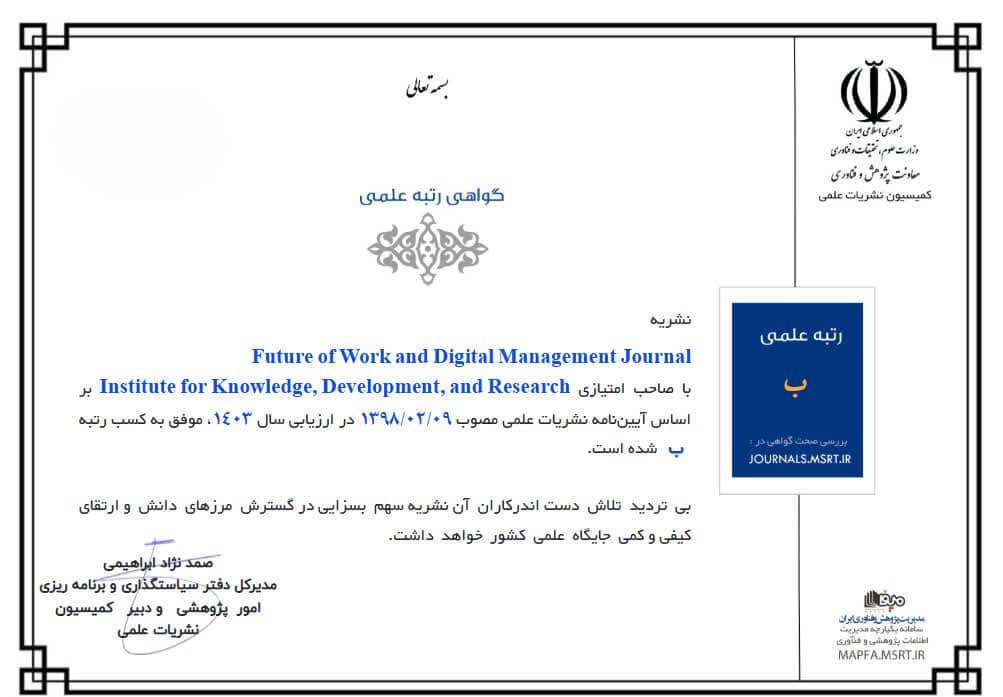Fraud Detection Analysis in Supplementary Health Insurance Using a Deep Neural Network (DNN) Model
Keywords:
Fraud detection, supplementary health insurance, deep neural networks, data preprocessing, machine learning, KerasAbstract
This study aimed to design and evaluate a deep neural network (DNN) model capable of accurately detecting fraudulent claims in supplementary health insurance by combining advanced data preprocessing, domain-specific feature engineering, and deep learning techniques. An applied research design was used with a real-world dataset of 20,000 insurance claims collected from a supplementary health insurance provider. Data integration was performed using SQL Server to unify multiple relational tables, including policy details, insured demographics, claim transactions, and disease information. Rigorous preprocessing included removal of irrelevant features, correlation analysis to eliminate multicollinearity (threshold >0.9), dimensionality reduction via Principal Component Analysis (PCA), imputation of missing values, outlier detection with the Interquartile Range (IQR) method, and normalization using standard scaling. A deep neural network was implemented with Keras, consisting of one hidden layer with 32 neurons using ReLU activation and a sigmoid-activated output layer for binary classification. The model was trained using the Adam optimizer and binary cross-entropy loss over 30 epochs with a batch size of 32. Hyperparameter optimization was supported by randomized search to identify the most effective architecture. The DNN model achieved exceptional performance in distinguishing fraudulent from legitimate claims. Precision, recall, and F1-score for both fraud and non-fraud classes reached 1.00, and overall accuracy was also 1.00. The receiver operating characteristic (ROC) curve showed an area under the curve (AUC) of 1.00, confirming perfect classification ability on the test dataset. The results demonstrate that combining domain-driven feature engineering with deep neural networks can produce highly accurate fraud detection models for supplementary health insurance. This approach provides a scalable and adaptable foundation for insurers seeking to minimize fraudulent payouts and enhance operational efficiency while setting the stage for integrating explainability and real-time detection in future systems.
Downloads
References
[1] M. Maheshwari and P. Begde, "The role of artificial intelligence and machine learning in enhancing tax compliance and fraud detection in India," Journal of Informatics Education and Research, vol. 5, no. 2, 2025.
[2] M. Mahmoudi and M. Shahrokh, "Machine Learning in Fraud Detection," 2024.
[3] S. K. Hashemi, S. L. Mirtaheri, and S. Greco, "Fraud Detection in Banking Data by Machine Learning Techniques," IEEE Access, vol. 11, pp. 3034-3043, 2023.
[4] A. Ali et al., "Financial fraud detection based on machine learning: a systematic literature review," Applied Sciences, vol. 12, no. 19, p. 9637, 2022, doi: 10.3390/app12199637.
[5] E. A. Minastireanu and G. Mesnita, "An Analysis of the Most Used Machine Learning Algorithms for Online Fraud Detection," Informatica Economica, vol. 23, no. 1, 2019, doi: 10.12948/issn14531305/23.1.2019.01.
[6] V. Chang, L. M. T. Doan, A. Di Stefano, Z. Sun, and G. Fortino, "Digital payment fraud detection methods in digital ages and Industry 4.0," Computers and Electrical Engineering, vol. 100, p. 107734, 2022/05/01/ 2022, doi: 10.1016/j.compeleceng.2022.107734.
[7] F. K. Alarfaj, I. Malik, H. U. Khan, N. Almusallam, M. Ramzan, and M. Ahmed, "Credit card fraud detection using state-of-the-art machine learning and deep learning algorithms," IEEE Access, vol. 10, pp. 39700-39715, 2022. [Online]. Available: https://doi.org/10.1109/ACCESS.2022.3166891.
[8] M. Isangediok and K. Gajamannage, "Fraud Detection Using Optimized Machine Learning Tools Under Imbalance Classes," 2022, doi: 10.1109/bigdata55660.2022.10020723.
[9] Z. Zhao and T. Bai, "Financial fraud detection and prediction in listed companies using SMOTE and machine learning algorithms," Entropy, vol. 24, no. 8, p. 1157, 2022, doi: 10.3390/e24081157.
[10] Y. Chen and Z. Wu, "Financial fraud detection of listed companies in China: A machine learning approach," Sustainability, vol. 15, no. 1, p. 105, 2022, doi: 10.3390/su15010105.
[11] U. Mukherjee, V. Thakkar, S. Dutta, U. Mukherjee, and S. K. Bandyopadhyay, "Emerging Approach for Detection of Financial Frauds Using Machine Learning," Asian Journal of Research in Computer Science, pp. 9-22, 2021, doi: 10.9734/ajrcos/2021/v11i330263.
[12] N. A. Le Khac and T. Kechadi, "Application of big data and machine learning in financial forensics and fraud detection," Forensic Science International: Reports, vol. 2, p. 100088, 2020, doi: 10.1016/j.fsir.2020.100088.
[13] A. H. Mohamed, M. A. Abourezka, and F. A. Maghraby, "A Comparative Analysis of Credit Card Fraud Detection Using Machine Learning and Deep Learning Techniques," pp. 267-282, 2021, doi: 10.1007/978-981-16-2275-5_16.
[14] A. Pumsirirat and Y. Liu, "Credit Card Fraud Detection Using Deep Learning Based on Auto-Encoder and Restricted Boltzmann Machine," International Journal of Advanced Computer Science and Applications, vol. 9, no. 1, 2018, doi: 10.14569/ijacsa.2018.090103.
[15] M. s. A. Jabbar and S. Suharjito, "Fraud Detection Call Detail Record Using Machine Learning in Telecommunications Company," Advances in Science Technology and Engineering Systems Journal, vol. 5, no. 4, pp. 63-69, 2020, doi: 10.25046/aj050409.
[16] I. Psychoula, A. Gutmann, P. Mainali, S. H. Lee, P. Dunphy, and F. Petitcolas, "Explainable machine learning for fraud detection," Computer, vol. 54, no. 10, pp. 49-59, 2021, doi: 10.1109/MC.2021.3081249.
Downloads
Published
Submitted
Revised
Accepted
Issue
Section
License
Copyright (c) 2026 Masoumeh Esmaeili, Mohammad Malekinia, Alireza Pourebrahimi (Author)

This work is licensed under a Creative Commons Attribution-NonCommercial 4.0 International License.







